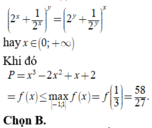1 phần 4 lớn hơn 1 ko.x x4 bằng x3
Hãy nhập câu hỏi của bạn vào đây, nếu là tài khoản VIP, bạn sẽ được ưu tiên trả lời.


Áp dụng tính chất dãy tỉ số bằng nhau ta có:
\(\dfrac{x_1-1}{5}=\dfrac{x_2-2}{4}=\dfrac{x_3-3}{3}=\dfrac{x_4-4}{2}=\dfrac{x_5-5}{1}\)
\(=\dfrac{\left(x_1-1\right)+\left(x_2-2\right)+\left(x_3-3\right)+\left(x_4-4\right)+\left(x_5-5\right)}{5+4+3+2+1}\)
\(=\dfrac{\left(x_1+x_2+x_3+x_4+x_5\right)-\left(1+2+3+4+5\right)}{15}\)
\(=\dfrac{30-15}{15}=1\)
\(\Rightarrow x_1=x_2=x_3=x_4=x_5=6\)
Vậy...
Áp dụng tính chất dãy tỉ số bằng nhau ta có:
\(\dfrac{x1-1}{5}\)=\(\dfrac{x2-2}{4}\)\(\dfrac{x3-3}{3}\)=\(\dfrac{x4-4}{2}\)=\(\dfrac{x5-5}{1}\)=\(\dfrac{x1-1+x2-2+x3-3+x4-4+x5-5}{5+4+3+2+1}\)=\(\dfrac{x1+x2+x3+x4+x5-\left(1+2+3+4+5\right)}{15}\)=\(\dfrac{30-15}{15}\)=\(\dfrac{15}{15}\)=1
\(\dfrac{x1-1}{5}\)=1 => x1-1=5 => x1 =6
\(\dfrac{x2-2}{4}\)=1 => x2-2=4 => x2 =6
\(\dfrac{x3-3}{3}\)=1 => x3-3=3 => x3 =6
\(\dfrac{x4-4}{2}\)=1 => x4-4=2 => x4 =6
\(\dfrac{x5-5}{1}\)=1 => x5-5=1 => x5 = 6
Vậy x1=x2=x3=x4=x5 =6

Đặt \(\frac{x_1-1}{5}=\frac{x_2-2}{4}=\frac{x_3-3}{3}=\frac{x_4-4}{2}=\frac{x_5-5}{1}=k\)
Áp dụng TC DTSBN ta có :
\(k=\frac{\left(x_1-1\right)+\left(x_2-2\right)+\left(x_3-3\right)+\left(x_4-4\right)+\left(x_5-5\right)}{5+4+3+2+1}\)
\(=\frac{x_1+x_2+x_3+x_4+x_5-15}{15}=\frac{30-15}{15}=1\)
\(\frac{x_1-1}{5}=1\Rightarrow x_1=6;\frac{x_2-2}{4}=1\Rightarrow x_2=6;\frac{x_3-3}{3}=1\Rightarrow x_3=6;\frac{x_4-4}{2}=1\Rightarrow x_4=6;\frac{x^5-5}{2}=1\Rightarrow x_5=6\)
Vậy \(x_1=x_2=x_3=x_4=x_5=6\)

a, \(\Leftrightarrow\left(9x^2-4\right)\left(x+1\right)-\left(3x+2\right)\left(x-1\right)\left(x+1\right)=0\)
\(\Leftrightarrow\left(x+1\right)\left(\left(9x^2-4\right)-\left(\left(3x+2\right)\left(x-1\right)\right)\right)=0\)
\(\Leftrightarrow\left(x+1\right)\left(9x^2-4-\left(3x^2-x-2\right)\right)=0\)
\(\Leftrightarrow\left(x+1\right)\left(9x^2-4-3x^2+x+2\right)=0\)
\(\Leftrightarrow\left(x+1\right)\left(3x^2+x-2\right)=0\)
\(\Leftrightarrow\left(x+1\right)=0;3x^2+x-2=0\)
=> x=-1
với \(3x^2+x-2=0\)
ta sử dụng công thức bậc 2 suy ra : \(x=\dfrac{2}{3};x=-1\)
Vậy ghiệm của pt trên \(S\in\left\{-1;\dfrac{2}{3}\right\}\)
b: \(\Leftrightarrow x^2-2x+1-1+x^2=x+3-x^2-3x\)
\(\Leftrightarrow2x^2-2x=-x^2-2x+3\)
\(\Leftrightarrow3x^2=3\)
hay \(x\in\left\{1;-1\right\}\)
c: \(\Leftrightarrow\left(x-1\right)\left(x+1\right)\left(x+2\right)\left(x-3\right)-\left(x-1\right)\left(x-2\right)\left(x+2\right)\left(x+5\right)=0\)
\(\Leftrightarrow\left(x-1\right)\left(x+2\right)\left[\left(x+1\right)\left(x-3\right)-\left(x-2\right)\left(x+5\right)\right]=0\)
\(\Leftrightarrow\left(x-1\right)\left(x+2\right)\left(x^2-2x-3-x^2-3x+10\right)=0\)
\(\Leftrightarrow\left(x-1\right)\left(x+2\right)\left(-5x+7\right)=0\)
hay \(x\in\left\{1;-2;\dfrac{7}{5}\right\}\)

Đặt x2−2x+m=tx2−2x+m=t, phương trình trở thành t2−2t+m=xt2−2t+m=x
Ta có hệ {x2−2x+m=tt2−2t+m=x{x2−2x+m=tt2−2t+m=x
⇒(x−t)(x+t−1)=0⇒(x−t)(x+t−1)=0
⇔[x=tx=1−t⇔[x=tx=1−t
⇔[x=x2−2x+mx=1−x2+2x−m⇔[x=x2−2x+mx=1−x2+2x−m
⇔[m=−x2+3xm=−x2+x+1⇔[m=−x2+3xm=−x2+x+1
Phương trình hoành độ giao điểm của y=−x2+x+1y=−x2+x+1 và y=−x2+3xy=−x2+3x:
−x2+x+1=−x2+3x−x2+x+1=−x2+3x
⇔x=12⇒y=54⇔x=12⇒y=54
Đồ thị hàm số y=−x2+3xy=−x2+3x và y=−x2+x+1y=−x2+x+1:

a, Đặt x2=t(t≥0)x2=t(t≥0)
x4−2mx2+2m−1=0x4−2mx2+2m−1=0
⟺t2−2mt+2m−1=0⟺t2−2mt+2m−1=0 (**)
Để phương trình có 4 nghiệm phân biệt thì Δ′>0⟺m2−2m+1>0⟺(m−1)2>0⟺m≠1Δ′>0⟺m2−2m+1>0⟺(m−1)2>0⟺m≠1 (1)
Và {t1t2=2m−1>0t1+t2=2m>0 (∗){t1t2=2m−1>0t1+t2=2m>0 (∗)
⟺m>12⟺m>12 (2)
Phương trình bậc 4 trùng phương thì có 4 nghiệm trong đó có 2 cặp nghiệm là số đối của nhau.
Mà x1<x2<x3<x4→{x1=−x4x2=−x3x1<x2<x3<x4→{x1=−x4x2=−x3
x4−x3=x3−x2→x4=3x3x4−x3=x3−x2→x4=3x3
TT: x1=3x2x1=3x2
→x1.x4=9x2.x3→t1=9t2→x1.x4=9x2.x3→t1=9t2 ( với t1;t2t1;t2 là 2 nghiệm của pt(**))
Đến đây thay vào (*) bên trên ta được hệ:
⟺{9t22=2m−15t2=m⟺{9t22=2m−15t2=m
→9(2)2−25(1)⟺9m2−50m+25=0⟺(9m−5)(m−5)=0→9(2)2−25(1)⟺9m2−50m+25=0⟺(9m−5)(m−5)=0
⟺m=59⟺m=59 v m=5m=5 (cả 2 đều thỏa mãn)
∙∙ Với m=59⟺x=±1m=59⟺x=±1 v x=±13x=±13
∙∙ Với m=5⟺x=±1m=5⟺x=±1 v x=±3


CÓ THỂ VT DỄ HỈU HƠN KHUM
Ok.1x3 x3